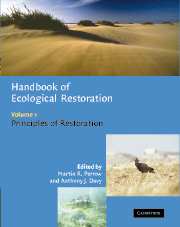Book contents
- Frontmatter
- Contents
- List of contributors
- Foreword
- Preface
- Part 1 The background
- Part 2 Manipulation of the physical environment
- Part 3 Manipulation of the chemical environment
- Part 4 Manipulation of the biota
- 12 Establishment and manipulation of plant populations and communities in terrestrial systems
- 13 Ecology and management of plants in aquatic ecosystems
- 14 Micro-organisms
- 15 Terrestrial invertebrates
- 16 Aquatic invertebrates
- 17 Fish
- 18 Reptiles and amphibians
- 19 Birds
- 20 Mammals
- Part 5 Monitoring and appraisal
- Index
- References
15 - Terrestrial invertebrates
Published online by Cambridge University Press: 29 December 2009
- Frontmatter
- Contents
- List of contributors
- Foreword
- Preface
- Part 1 The background
- Part 2 Manipulation of the physical environment
- Part 3 Manipulation of the chemical environment
- Part 4 Manipulation of the biota
- 12 Establishment and manipulation of plant populations and communities in terrestrial systems
- 13 Ecology and management of plants in aquatic ecosystems
- 14 Micro-organisms
- 15 Terrestrial invertebrates
- 16 Aquatic invertebrates
- 17 Fish
- 18 Reptiles and amphibians
- 19 Birds
- 20 Mammals
- Part 5 Monitoring and appraisal
- Index
- References
Summary
INTRODUCTION
In this chapter we outline some of the invertebrate-related issues that need to be considered during the restoration of ecosystems. Since a major factor in relation to this involves knowing what is present in the area, we also discuss the sampling protocols that need to be followed when surveying the invertebrate fauna. Readers are referred to the book Animals in Primary Succession: The Role of Fauna in Reclaimed Lands (Majer, 1989) for a comprehensive account of the importance of invertebrates in restored areas.
Horwitz et al. (1999) point out that restoration of a system requires more than just recreating the vegetation assemblage. Restoration may be deemed to have failed unless the services of nutrient retention and cycling, purification of air and water, detoxification and decomposition of wastes, pollination, dispersal of seeds, and other ecosystem services are recovered. Invertebrates dominate the functions and processes of most ecosystems. The goods and services provided by these systems to humanity rely on their invertebrate communities and the ecological processes that are driven by these animals. Anyone who is concerned with restoration of ecosystems must therefore consider this important component of the biota, both in terms of its role and its diversity. Although not necessarily linearly related (Schwartz et al., 2000), the links between biodiversity and ecosystem functioning are demonstrable, and reflect the increased functional roles that are possible in ecosystems that contain more species (see Tilman, 1997).
- Type
- Chapter
- Information
- Handbook of Ecological Restoration , pp. 279 - 299Publisher: Cambridge University PressPrint publication year: 2002
References
- 8
- Cited by



